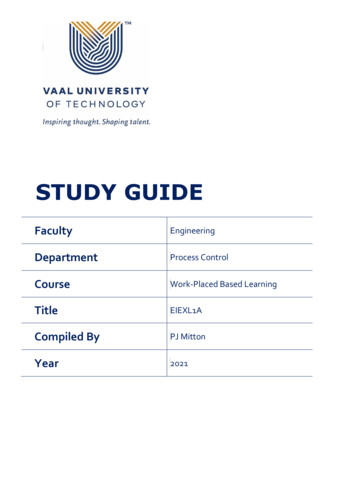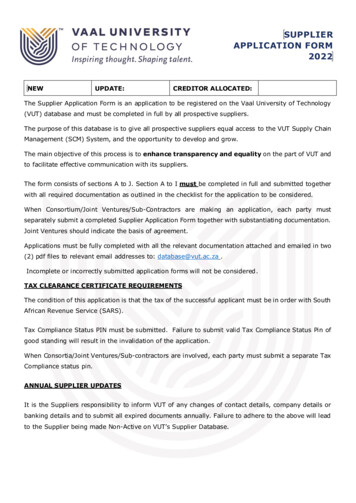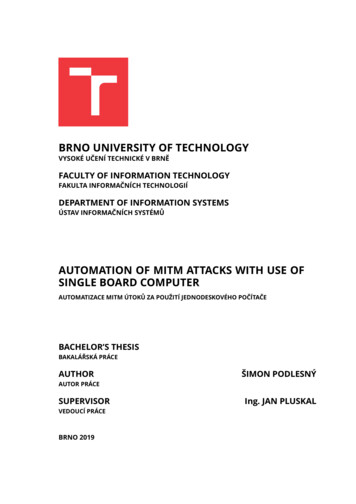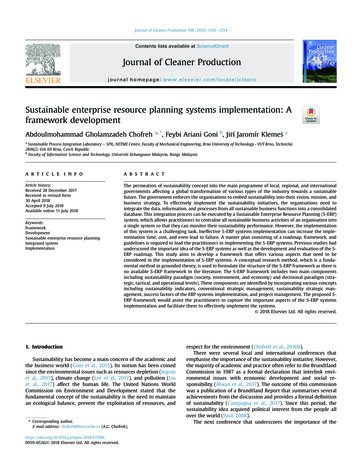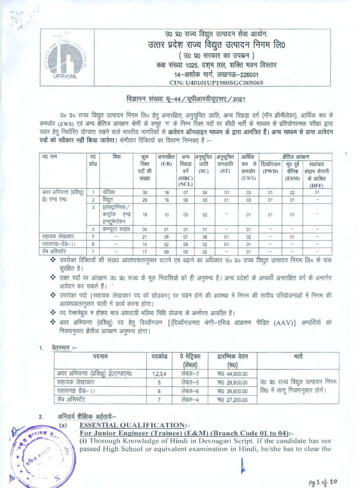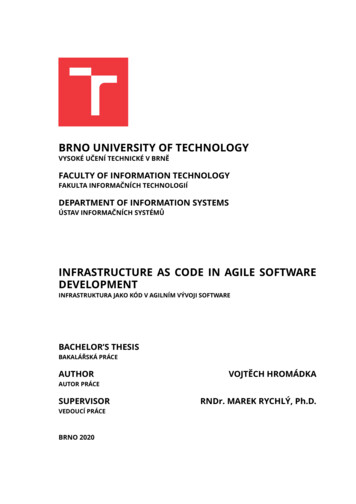
Transcription
BRNO UNIVERSITY OF TECHNOLOGYVYSOKÉ UČENÍ TECHNICKÉ V BRNĚFACULTY OF INFORMATION TECHNOLOGYFAKULTA INFORMAČNÍCH TECHNOLOGIÍDEPARTMENT OF INFORMATION SYSTEMSÚSTAV INFORMAČNÍCH SYSTÉMŮINFRASTRUCTURE AS CODE IN AGILE SOFTWAREDEVELOPMENTINFRASTRUKTURA JAKO KÓD V AGILNÍM VÝVOJI SOFTWAREBACHELOR’S THESISBAKALÁŘSKÁ PRÁCEAUTHORVOJTĚCH HROMÁDKAAUTOR PRÁCESUPERVISORVEDOUCÍ PRÁCEBRNO 2020RNDr. MAREK RYCHLÝ, Ph.D.
Brno University of TechnologyFaculty of Information TechnologyDepartment of Information Systems (DIFS)Academic year 2019/2020Bachelor's Thesis SpecificationStudent:Hromádka VojtěchProgramme: Information TechnologyTitle:Infrastructure as Code in Agile Software DevelopmentCategory:Information SystemsAssignment:1. Study Infrastructure as Code (IaC) technologies (e.g., Terraform, Chef, Ansible, CloudFormation, Google Deployment Manager), evaluate and compare these technologies. Makeyourself familiar with Continuous Delivery and Continuous Integration (CI/CD) concepts,technologies, and applications in agile software development.2. Choose one IaC technology and describe its utilisation and possible issues in CI/CD in agiledevelopment using a Git code repository.3. Design an agent which controls concurrent access to infrastructure resources in a cloud andprevents collisions of concurrent IaC deployments.4. After consulting with the supervisor, implement the agent and demonstrate its usage inappropriate examples.5. Describe, evaluate and publish the results as an open source.Recommended literature:Yevgeniy Brikman. Terraform: Up & Running: Writing Infrastructure as Code. 2nd ed.O'Reilly Media, 2019. ISBN 1492046876.Gene Kim, Jez Humble, Patrick Debois, John Willis. The DevOps Handbook: How to CreateWorld-Class Agility, Reliability, and Security in Technology Organizations. IT Revolution,2016. ISBN 194278807X.Detailed formal requirements can be found at hlý Marek, RNDr., Ph.D.Head of Department:Kolář Dušan, doc. Dr. Ing.Beginning of work:November 1, 2019Submission deadline: July 31, 2020Approval date:October 21, 2019Bachelor's Thesis Specification/23145/2019/xhroma13Page 1/1
AbstractThis thesis is focused on the usage of infrastructure as code in agile software development.Concepts such as continuous integration and delivery, DevOps are analyzed. Further cloudenvironments are analyzed. In this work are compared different infrastructure as code tools.For the prevention of possible issues in using infrastructure as code software was designed.The software purpose is to control concurrent access to infrastructure creation with a toolcalled Terraform. The software was then is for experiments. The first experiment demonstrates that workflow with Terraform agent is behaving correctly. The second experimentsdemonstrate control of concurrent access to infrastructure creation.AbstraktTato bakalářská práce je zaměřena na využívání infrastruktury jako kódu v agilním vývojisoftware. Rozebírá další obvyklé koncepty, které jsou používány při agilním vývoji mezikteré patří DevOps, kontinuální integrace a doručování. Dále je zaměřena na využitícloudu a na porovnávání jednotlivých nástrojů využívaných v infrastruktuře jako kódu.Pro prevenci možných problémů při využívání infrastruktury jako kódu byl navržen software, který má za účel kontrolovat souběžný přístup k vytváření infrastruktury s nástrojemTerraform. S tímto softwarem byly následně provedeny dva experimenty. První experimentdemonstruje zdali lze uplatnit navrhovaný pracovní postup se softwarem, druhý experimentdemonstruje správnost řešení při souběžném přístupu.KeywordsInfrastructure as code, Agile development, Terraform, DevOps, CloudKlíčová slovaInfrastruktura jako kód, Agilní vývoj, Terraform, DevOps, CloudReferenceHROMÁDKA, Vojtěch. Infrastructure as Code in Agile Software Development. Brno,2020. Bachelor’s thesis. Brno University of Technology, Faculty of Information Technology.Supervisor RNDr. Marek Rychlý, Ph.D.
Rozšířený abstraktVyužívání agilních metodik ve vývoji software roste čím dál tím více na popularitě. Vývojářské společnosti jsou schopni díky těmto metodám rychleji reagovat na požadavky odzadavatele, a tím přizpůsobit software dle nejnovějších potřeb. Obvyklou součástí agilníhovývoje spočívá v přijetí DevOps kultury, která významně pomáhá urychlit proces doručovánív podobě vytváření automatizovaných procesů jako je kontinuální integrace a kontinuálnídoručování.Nedílnou součástí DevOps kultury a agilního vývoje je využívání nástrojů za účelemvytváření infrastruktury jako kódu. Infrastruktura jako kód umožňuje abstrakci samotnéhohardware do formy kódu jako je tomu zvykem při vytváření software. Pro vyváření infrastruktury jako kódu existuje několik nástrojů, které podporují vytváření infrastruktury navirtuálních strojích nebo nástroje které zajišťují prostředky od cloudových poskytovatelů.Tyto nástroje se obvykle dají zakomponovat do autimazitovaných rutin jako je kontinuálnídoručování.Tato práce se zaměřuje na uvedení čtenáře do problematiky DevOps a praktickýchvyužití metod, které zrychlují vývoj a doručování softwaru zejména z pohledu vytvářeníinfrastruktury s pomocí infrastruktury jako kódu.Cílem této práce je prozkoumat možnosti infrastruktury jako kódu a popsat možnývýskyt problémů při využívání daných nástrojů, poté navrhnout agenta, který zabráníkolizím při souběžném vytváření infrastruktury v cloudovém prostředí.Hlavní částí celé práce je návrh a implementace serverového agenta, který je integrovanýdo cloudové služby, tak aby byl schopný kontrolovat souběžný přístup k změnám infrastruktury. Pro vytvoření takového agenta je nutné zvolit nad kterým nástrojem bude pracovat.Prozkoumat jak daný nástroj pracuje, jaký je jeho obvyklý pracovní postup a ten potomzapouzdřit a vylepšit o požadované funkce.Pro účely této práce je vybrát Terraform, který se jeví jako univerzální nástroj infrastruktury jako kódu. Následně jsou navrhnuty vylepšení pracovního postupu s danýmnástrojem a to tak, že by měli zlepšit týmovou spolupráci. Navržený agent spolupracujes verzovacím systémem GitHub tak, že pokaždé při vytváření nové verze infrastruktury,agent zajistí aby byla vytvořena nejnovější verze na základě posledních změn na GitHubu.To všechno je na závěr práce naimplementováno a agent je nasazený do cloudu. Určitéaspekty související s agentem jsou integrovány do cloudového prostředí pro správnou funkcionalitu celého programu. Druhá implementovaná část je klientská část programu, která jeschopná komunikovat s agentem pomocí volání API.Jako poslední bod práce jsou provedeny náležité experimenty, které demonstrují funkčnostsoftwaru a zároveň vysvětlují využití v praxi. První experiment má na starost zjištění základních požadavků na software jako je navržené zlepšení týmové spolupráce. Druhý experiment zobrazuje funkčnost programu při souběžném pokusu o vytvoření infrastrukturu.
Infrastructure as Code in Agile Software DevelopmentDeclarationI hereby declare that this Bachelor’s thesis was prepared as an original work by the authorunder the supervision of RNDr. Marek Rychlý, Ph.D. I have listed all the literary sources,publications and other sources, which were used during the preparation of this thesis.Vojtěch HromádkaJuly 30, 2020AcknowledgementsFirst I would like to thank my supervisor, RNDr. Marek Rychlý, Ph.D. For his willingnessand his advice while creating this work. Also, I would like to thank Ing. Peter Malina fromFlowUp that he helped me to put together the assignment of this thesis.
Contents1 Introduction2 Agile development2.1 DevOps . . . . . . . .2.2 Continuous integration2.3 Team collaboration . .2.4 Containerization . . .2.5 Cloud vs on-premise .2.6 Cloud-native . . . . .2.7 Cloud Providers . . . .2.3457899113 Infrastructure as a code3.1 Existing Infrastructure as Code Tools . . . . . . . . . . . . . . . . . . . . .3.2 Cloud specific IaC tools . . . . . . . . . . . . . . . . . . . . . . . . . . . . .3.3 Research on similar existing solutions . . . . . . . . . . . . . . . . . . . . .131415164 Design4.1 Terraform workflow . . . . . . . . . . . . . . . . . . . . . . . . . . . . . . . .4.2 Designing the agent . . . . . . . . . . . . . . . . . . . . . . . . . . . . . . .1818195 Implementation5.1 Server Side . . . . . . . . . . . . . .5.2 Client . . . . . . . . . . . . . . . . .5.3 Securing connection . . . . . . . . .5.4 Cloud configuration and deployment.23232626276 Experiments6.1 Experimment 1 . . . . . . . . . . . . . . . . . . . . . . . . . . . . . . . . . .6.2 Experimment 2 . . . . . . . . . . . . . . . . . . . . . . . . . . . . . . . . . .2828307 Conclusion32Bibliography33A Content of the storage medium35. . . . . . . .and delivery. . . . . . . . . . . . . . . . . . . . . . . . . . . . . . . . . . . .1.
Chapter 1IntroductionSoftware development methods are growing increasingly with a passion for agile development. The agile concept is focused on fast reaction to changes during development and fastdelivery of new versions of the software even with small incremental changes.Chapter 2 is about brief insight into agile and DevOps culture, about its utilizationand common practices that are adopted by these cultures and how cloud is taking place inthe current market and its benefits compared to on-premise solutions.For agile development, proper tooling must be chosen to be able to deliver fast, withconfidence and without errors. A Teams first steps to practising agile are usually utilisingcontinuous integration and continuous delivery tools to build, test and deploy applications,but it does not end there.In the actual world where cloud computing is increasingly getting popular, enterprisesadapting tooling in form of infrastructure as code which allows abstract the physical layerof infrastructure. Infrastructure as code allows creating multiple environments of a projectwithout the challenge to manage them all manually. A closer look into infrastructure ascode practices is in Chapter 3.This thesis focuses on practical aspects of using infrastructure as code in agile development and cloud environment. In Chapter 4.2 is designed agent that should improveteam collaboration and allow control of concurrent access of creation infrastructure withTerraform tool to prevent collisions.The motivation behind creating software that can control concurrent access to the infrastructure changes is to help enterprise teams to collaborate better without the need ofexplicit communication of new changes and also removing the urge of having dedicatedteam members to manage this kind of operations.Chapter 5 focuses on the implementation of the Terraform concurrent agent and describes the approach that is used to create the application and how it is integrated intoGoogle Cloud.Last Chapter 6 describes testing and experimenting with the final application in the realscenarios and shows how the Terraform concurrent agent could be utilized in the development of larger projects.2
Chapter 2Agile developmentAgile development is one of many development methodologies. This type of methodologyis built on principles like simple design, continuous delivery, self-organizing teams and faceto-face communication, fast response. These principles are derived from four core agilevalues.Composition of four agile values: Individuals and interactions over processes and tools Working software over extensive documentation Collaboration with customer over contract negotiation Responding to change over following a planIn agile development value on the left side is more important than values on the right.However, it does not mean that values on the right side are not important. Accordingto the set of these values twelve agile principles were proposed. These principles enhancethe importance of agility in software development.Some principles derived from these values are improved by using a cloud environment fordevelopment. Such as scalability, providing infrastructure (both hardware and software),fast delivery mechanisms, lowering cost and increasing software quality. In the biggerpicture cloud computing affects agile software development with increasing prominence [22].Agile software development has various methods and since general talk about it maynot give a clear idea of how agile development works, Scrum is stated as the most popularagile framework.ScrumScrum is defined as a flexible, holistic product, a development strategy where developerswork as a unit to reach a common goal. One development cycle is called Sprint. Sprints areusually no long-term plans that have an elected amount of features that are implementedin one development cycle. After every sprint, Sprint Planning is arranged to prioritizethe features. Sprints are created from Sprint Backlogs which works as a to-do list.In Scrum daily meetings are held. Each team member should be prepared and shareanswers to three basic questions. What did the member yesterday do that contributed to sprint goal?3
What does the member plans to do today? Are there any difficulties that can prevent the member from contributing?After each iteration, team members are part of a Retrospective meeting where theyshare and identify lessons and improvements for the next sprints [22].With this simple example of how scrum works, it is safe to say that in the modernworld agile development is a great way to work on projects for customers that are drivenby fast-changing demand on the market as agile offers solutions for certain problems.2.1DevOpsIn the first place, DevOps is a culture, not a specific method on how to approach an issue.However, there exist tactics that should help to create own methods which could shortenoperations of software design changes [1].DevOps is a culture and a mindset of people practising it. For most cases, that cultureis about trust, team empowerment and cooperation. It also means DevOps is open tolearning new things and finding solutions [16].Figure 2.1: Misunderstanding is frequent event in divided teamsDividing software development team into the development and operations team is a longlasting practice. Both teams have different needs and ideas. The development team wouldlike to release the newest features as soon as possible. On the opposite hand, the operationsteam would prefer the stability of software over releasing new versions.The essential idea behind DevOps is quite simple. Build a bridge between developmentand operations team. The development team should know what needs to be done bythe operations team and vice versa. Ideally, operations should be part of the developmentteam, so that everyone has the same knowledge base.Another approach of building the bridge between those two teams is to merge them,where both developers and operations could do the same work. Develop and deploy theirwork later on without being dependent on the second team.With both of those approaches, development may concentrate on creating features toproduction as fast as possible or delivering on time with good quality instead of blamingthe second team for their mistakes. Both approaches support the agile concept of fastdevelopment.4
Why is DevOps important? In current IT market is dominated by the speed of releasingproducts. This can be seen by the popularity of agile techniques to shorten development cycles. And when development cycles are fast enough, there is a bigger need to correctly createspace where that product can be placed and regularly updated. With DevOps, it is saferto make changes more often because of automated pipelines of the whole deployment [1].DevOps in practiseDevOps work usually lays in increasing automation and faster deployment process.First DevOps task is to create an automated deployment mechanism. Deployment strategy is mostly based on deployment scripts or some continuous delivery system, which istriggered by the CI system. Strategies to deploy to different environments such as development or production may differ. While the development environment is usually automated.Deployment to production often needs manual triggering.Infrastructure as code, provisioning and configuring environments repeatedly and reliably is part of DevOps expertise and can be part of the CI/CD1 pipeline. Tools such asTerraform, Chef or Puppet are used for this purpose. Infrastructure as code is mentionedin Chapter3Developers and operators actively monitor applications and services that were developed, both in production or other environments. Monitoring is done for various purposes,such as providing visibility over failures of deployment or quality of provided services. Withproper monitoring faster response to bugs and anomalies is achieved which leads to greatercustomer satisfaction [16].Figure 2.2: DevOps cycle [20]2.2Continuous integration and deliveryContinuous integration (CI) and continuous delivery (CD) embody a culture, set of operatingprinciples, and collection of practices that enable application development teams to delivercode changes more frequently and reliably. The implementation is also known as the CI/CDpipeline and is one of the best practices for DevOps teams to implement. [18]To be able to create your CI/CD pipeline, proper tooling and technology must be chosen.While implementing a CI/CD, teams have to decide which tools fit best in their businessand technology stack.1Continuous integration/Continuous delivery5
Continuous integrationContinuous integration is a philosophy that supports rapid software development. Operating principles are based on that philosophy and they help to achieve delivering of new codefrequently and reliably. Using this method it is easier to detect bugs in code sooner than inlarge additions of code less often.Teams that want to implement CI/CD to their business often start with version controlsystems. Code checking can be done frequently for smaller features but also for longer timeframes. Development teams are using different strategies for different cases and define howcode is merged into production environments.There are many techniques like version-control branching, which is based on creatinga branch for each environment where software is running. One branch is development, forthe newest features. The second branch is created for testing, where the testing is doneand after all the needed steps are done, code is merged to the production branch whichrepresents the code used in the latest version of the production system.The second strategy could be feature flags. This mechanism is built around turning onor off features at run time. A production system is using master branch code to run. Newestfeatures are flagged and until they are tested, they can not be flagged as production-readyso neither be deployed.Building the software as a whole is then automated by packaging all the code, databaseand other components. This packaging may differ depending on which languages areused. [18]Continuous deliveryContinuous delivery is part of CI/CD that delivers software to its desired environments.Usually, teams have more environments such as development, testing and production. Eachof those environments should have same configurations but are for different purposes.The objective of continuous integration is to gather code at one place to be handed tocontinuous delivery. After everything is set up, a continuous delivery process could looklike this:First, the code is pulled from a version control system and starts a build of an application. Then the infrastructure as code tool is executed to change required infrastructure ina given environment. This step is more important for a cloud environment as they are moremutable. Next step is moving a built application to the target environment and configuringenvironment variables dependent on the environment that is being used. After everythingis set up, the application is pushed to their appropriate services, such as web servers, APIservices. Then an application is deployed, the last thing to do is execute any steps requiredto restart services that are needed for new code to take effect. At the moment when isapplication successfully deployed, continuous tests are executed, if tests fail rollback will beapplied.More and different steps could be part of continuous delivery. Those which are mentioned here should give a good understanding of a given problematic [18].Testing in CI/CDThe vast part of CI/CD is testing. The optimal case is to deliver new versions of software asquickly as possible. Also, quality assurance is very important. This means that the CI/CDpipeline should have included various types of tests to be executed in process of delivering6
new versions, and in case tests will find an error in code or delivery process, a rescueplan should exist. That rescue plan might be a rollback to the previous version.However, the best practice in testing is before continuous delivery is executed. Beforereleasing a new feature, developers should run unit tests, functional tests and regressiontests on their local environment. This leads to correct code in version control systems aftercommitting a new portion of code without breaking the working environment.Testing code is the first part of the testing of the whole software. There are more likeperformance testing, API testing, security testing, all these can be also automated. The keyto automating these tests is the ability to trigger them some easy way such as the commandline.When all testing is automated, it can be integrated into the CI/CD pipeline. Raw codetesting can be done in CI while committing or merging with the master branch. Other testslike performance testing could be done only after deploying the new version to the targetenvironment and if those fails, rollback can be executed [18].Figure 2.3: CI/CD process [7]2.3Team collaborationIn today’s world where is a big demand on speed and even more in agile development.Teams have to choose the best way to collaborate. In software development, there area few points of view. First, that should come in mind is how to effectively share code withthe team. In history, before 2005 teams used to share code within version control systemsthat were centralized and they usually stored each version of the software. They primarilyoffered prevention of bad things happening, but they did not help in developers daily lifevery much. Git changed that with its branching system and better control of code [19].GitBirth of Git helped developers to create revisions, not only versions of the software. Softwaredevelopment changed because there were many benefits to this approach. Instead of writinga whole new version based on a previous one, teams could easily implement to their workflowsmall incremental additions. Git offers a branching system, where developers can create7
a new branch from the latest version which gives them a complete copy of the softwarerepository and allowing them to do their individual needs such as new feature or bug fix.Git also keeps a graph which contains a complete history of commits and mergingbranches. That helps developers to identify problems with each version and can be easilyreverted or reviewed.The big plus of git is that it is decentralized and allows great local development evenwithout internet access. Each individual of a team can clone a repository to a local computerand work with it on their computer. They can commit changes that are ready to be partof the remote repository. Those pushed commits are usually reviewed by other membersand then integrated to a master branch which can be production code [19].GitOpsGitOps uses git repository or another VCS2 to improve the work of the operations or DevOpsteam. With GitOps practice configuration files of infrastructure, container-orchestrationand other important segments of the software are stored in VCS. Configuration files ofinfrastructure and other tools are written in a declarative style. These source repositoriesare becoming a source of truth for the whole project in repositories.Before GitOps, it was common to write a deployment ticket and wait until an operatorsuccessfully deploys the application. Now it is more frequent to edit changes in the repository and create a pull request (PR). After that PR is reviewed by other team members,automated pipeline (CD) is triggered and changes of infrastructure and other configurationsare executed.The fact that GitOps is realized leads to easier testing different environments, reducesbus factor“, reduces wait time before a new version is deployed and improves overview of”infrastructure logic which is handled by infrastructure as code (IaC). Manual toil is alsogreatly reduced. Very important is that GitOps improves the ability to operate systemssafely because operators now do not need to spend so much time with toil3 , they can spendmore time on improving CI/CD pipeline which leads to better automation [15].2.4ContainerizationContainers improve the way the organizations deliver services to end-users. Containers improve agility because applications are a faster and more flexible way than using monolithicarchitectures which make applications difficult to update. Containers can be shipped asa whole to correct the place and replace the older version of service without noticeable impact. That approach significantly helps to deliver changes sooner than before as it is easierto write the code and create a container [3]. Containers offer light-weight virtualisation,faster than Virtual Machines. Containers provide the ability to manage and migrate application dependencies along with the application with omitting the underlying operatingsystem [8].The most popular containerization engine is Docker. Docker creates containers withDocker files to create Docker images which are then deployed to the prepared infrastructuremanually, or in CI/CD pipeline.23version control systemrepetitive time-consuming activity8
Figure 2.4: Different type of virtualizing application virtual machines versus containerization2.5Cloud vs on-premiseSmall and medium-sized enterprises (SME) might want to keep their business small orto grow it. When they start to grow it may get harder to manage IT infrastructure.With a bigger company, more on-premise hardware is needed and it can grow gradually orexponentially and takes usually a long time to return on investment [21].With cloud computing there is no need to take care of your infrastructure, it is providedfrom a cloud provider in a form of Infrastructure as a service or Platform as a service. Cloudoften offers to pay as you go, which means it does not involve large initial investment [8][21].2.6Cloud-nativeCloud-native is a well-known term but is not that often described more than we are on”a cloud“. There are many key ideas behind being Cloud-native. One of them is specific design patterns that became very successful while creating cloud applications. Most frequentarguments of cloud-native are as following. Cloud-native applications can operate on a global scale. The ordinary web applicationcan be accessed anywhere in the world through the internet. Cloud-native applicationhas replicas of servers and data centres around the whole world so that accessingapplication results in minimal latencies, for example, google sites can be reached fromEurope with lowest latencies, even though Google is located in the United States ofAmerica. That is because they have replicas in many places in Europe. This approachcreates very robust applications. Cloud-native applications have to scale well with many concurrent users. Assumptionhere that application can horizontally scale automatically. That approach requirescareful observation of synchronization and consistency in distributed systems.9
Applications are built on assumption that infrastructure is unstable. Even thoughone zone of servers will crash down because of some natural disaster the applicationwill still run in a different place so the user does not realize that there is trouble. Upgrading or testing Cloud-native applications do not affect end users. Security must not be forgotten, cloud-native applications are built of many smallcomponents and these components can not hold sensitive data. Access control needsto be managed at multiple levels.There are many cloud-native applications that the population uses every day but maybedoes not know that it is a cloud-native application. For example, The Netflix movie streaming service is one. Also other big players in the current world such as Facebook, Twitter.At first to become cloud-native, Infrastructure as a Service replaces on-premise infrastructure with virtual machines running in the cloud. It was very difficult to engineerscalability and security at the same time with only on-premise solutions.The first major design pattern for cloud-native applications was Microservice architecture. This architecture relies on dividing application to small independent components andit easy to scale and reliable. That each component is called microservice. All microservicesshould be designed for constant failure and recovery.It must be possible to encapsulate each microservice instance so that it can be easilymanipulated. Containerization is the solution.With all this, it is possible to create a well-developed cloud-native application based onmicroservice architecture [8].Figure 2.5: Basic principles of cloud-native development [12]10
Full stack example of Cloud-Native applicationBefore creating a new cloud-native application, it is good practice to choose proper tooling,there are a lot of tools for different parts of the application.On the bottom of the whole application should lay a cloud environment. At the momentthe cloud marke
Gene Kim, Jez Humble, Patrick Debois, John Willis. The DevOps Handbook: How to Create World-Class Agility, Reliability, and Security in Technology Organizations. IT Revolution, . continuous delivery. After everything is set up, a continuous delivery process could look likethis: First .
